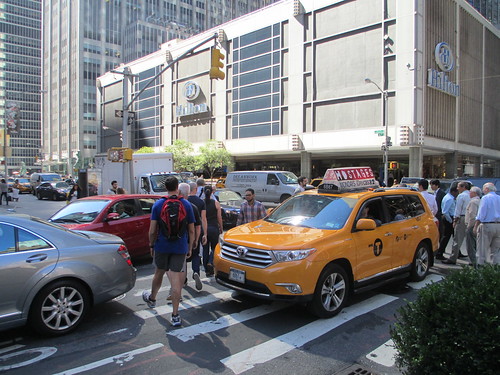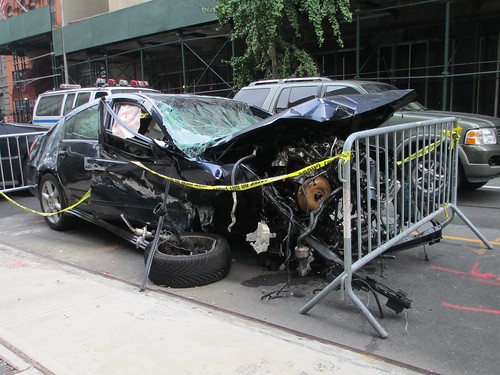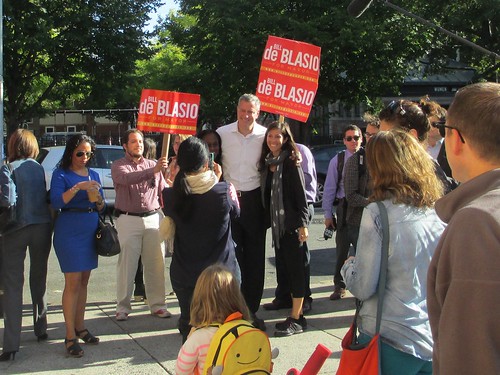The inspector’s accent was so Old New York it ought to be
put in a museum or taped for use in announcements on the subway’s nostalgia
trains.
“Turn on da vehicle and, when you’re ready, move off,” he
told me.
Sensing that, like a true New Yorker, this employee of the
New York State Department of Motor Vehicles was in no mood to wait around, I
started the driving school’s ageing Hyundai Elantra, I looked carefully into my
mirrors and over my shoulder, signalled and pulled out. I was, finally, taking the
road test to get my New York
State
 |
| 20th Avenue, Astoria, Queens: a slice of wide-laned suburbia that I'll always associate with pre-test nerves |
Thanks to those nerves, I had begun as I cycled from home towards
the test site to dwell on the vagaries of the licensing process. Vast
swathes of the information I’d been given had been focused, it seemed to me,
more on making sure I’d be a compliant, cooperative participant in traffic than
on making sure I’d pose minimal safety risks to others. There had been lots of
mentioning of individual rules. There had been very few efforts to underline
the general principle that I should behave safely and considerately.
“Make a left here,” the instructor told me, pointing up a hill
way from the power station that takes up one side of 20 Avenue in Astoria , the part of Queens
where I was taking the test.
I should make it clear, since people have asked, that my
deciding to get a New York
driving licence doesn’t reflect some Damascene conversion to the cause of
driving or a first step towards buying a motor vehicle. I continue largely to
dislike driving, which is especially stressful when one’s used to using the
streets as a cyclist and aware of how frightening cars can be for other road users.
None of my misgivings, however, negates the fact that it’s
occasionally extremely useful to be able to drive, particularly during our
annual family summer holiday and on certain work trips. Being a rules-focused,
cautious person, I had also grown increasingly nervous about the legal niceties
of using my UK licence to
drive in the US three years
after I moved to New York .
After hearing a colleague describe how she’d been fined $800 after she showed a
police officer her Brazilian driving licence after several years’ US residence, I
had reluctantly decided I could ignore the whole muddly issue no longer.
“I want you to move over here to the right – MOVE OVER HERE
TO THE RIGHT – and park behind this vehicle,” the instructor said.
 |
| For fans of the blatantly obvious: the Department of Motor Vehicles' probing questions about alcohol and driving |
Even the first step – taking a written, multiple-choice test
– had felt like a not-very-subtle form of indoctrination. There had been some
straightforward questions about safety rules. It turned out, for example, that only time could counteract the effects of alcohol, not having a cold shower or a coffee. The correct answer on how to proceed when railroad
crossing barriers started coming down had been to stop and wait, not to zig-zag
round the barriers.
But a fair number of the questions, it seemed to me, had focused
on rules that were mainly about keeping the roads moving smoothly. “You are
making a left turn from a two-way street into a one-way street,” one question
read, before giving four alternatives on which lane one should use after
turning.
Worse still had been the relative paucity of questions about
driving around pedestrians and managing the complex rules around their right of
way. I strongly suspect most New York
drivers don’t recognise that there is, legally speaking, an unmarked crosswalk,
where pedestrians have right of way over turning vehicles, at even unsignalled
intersections. Nothing in the written test would have prompted them to find out
about that.
 |
| How might the victim be to blame for your crashing into him or her? Some of the DMV's bizarre questions about cyclists and other vulnerable road users |
The most bizarre questions, meanwhile, had been about
bicycles. “Motorists should be aware that all bicycles used after dark must
have” one question asked before listing as alternatives “reflective handlebar
grips,” “front headlight and rear taillight,” “white reflectors on the front
and rear fenders” and “brake lights”. “A motorist should know that a bicyclist
operating on a roadway must” read another before listing as alternatives “ride
on the right side of the road,” “ride on the side of the road facing traffic,”
“ride on either side of the road” or “ride on the side of the road with the
least traffic”. The correct answer for the side of the road question was that
the cyclist should ride on the right – an answer so riven with exceptions under
New York City
law as to fuel the already considerable misunderstandings between cyclists and motorists.
Given that the test was for a licence to drive a motor
vehicle, the only possible explanation for these questions was to give
motorists excuses to be frustrated with cyclists. In the several practice tests
I tried and the test I actually took, the nearest I encountered to a question
asking about safe driving around cyclists was one that asked how a motorist
should behave when trying to pass a cyclist. But the correct answer - “exercise
extreme caution” – was less close to truly safe behaviour than another answer –
“swerve into the opposite lane” – that had been written to appear absurd.
Those and other questions had read as if written by some
ill-informed angry motorist eager to get other drivers and cyclists to stay
sensibly out of his way, rather than a considered effort to filter out bad
drivers. My over-liberal ideas about where cyclists are allowed to ride on the
road had cost me one of the 20 points on offer. I had been surprised as I
waited afterwards to receive a temporary learner’s permit to hear another test
participant berating the staff because he had fallen short of the 14 out of 20
pass mark.
“OK,” the examiner said. “Make a left here.”
 |
| Everyone hunches over their mobile phones before a five-hour lesson that ignores their effects on road safety |
Much the strangest part of the process had been
the compulsory, five-hour classroom lesson I had to take back in May. Just
before 10am one Saturday, I had cycled to an unglamorous storefront in Sunset Park ,
where a rotund man from the Caribbean called
Raymond had talked to us, essentially, about how to get through the coming road
test. During the road test, he’d told us, it was vital to pause for any
pedestrian anywhere near a crosswalk before turning through it. During the road
test, he’d gone on, it was vital not to exceed the city’s new 25mph speed
limit. During the test, it was important not to swing onto the wrong side of
the road while turning a corner. That was a definite fail. These were the
unreasonable requirements of the finicky old test, it was strongly implied.
Such prissy behaviour wouldn’t be necessary once we were properly licensed
drivers.
Raymond had then padded out the time by showing us a series
of films, none made more recently than 1997, covering a series of safety
themes. Much the worst was a film, dressed up as a corny noir detective
thriller, about the mystery of how anti-lock brakes behave in an emergency. Drivers
would have to change their old habits to adapt to this new technology, it
warned. Another had covered how to drive in adverse weather conditions. “The
first question is, ‘What’s the most important thing you can do to improve
safety in adverse driving conditions?’” a man in a suit and tie asked. “And the
answer is, ‘Slow down’,” answered a woman with curly, 1990s hair, making a
downward movement with her hands for emphasis.
The two most effective films had focused on the suffering of
bereaved families. One described the death of Nancy McBrien, a US navy officer killed in 1996 on the George Washington Parkway
near Washington .
She died when two angry drivers jostling with each other crashed, sending one
of their vehicles across the parkway’s central reservation and into Cmdr
McBrien’s car. The other covered the effects of the behaviour of Bruce Kimball,
a former US Olympic diver
who in 1989 drove drunk and crashed into a group of teenagers in Florida , killing two and
seriously injuring four.
The anti-lock brake video had been especially misdirected. It
was warning course participants – most around 20 - of the challenges of
adapting to a technology that became near-universal around the time they were
born. Even the more effective videos, meanwhile, had been potentially
counterproductive. Both had reflected specific moral panics over specific
apparent social phenomena – teenage drink-driving and road rage. Yet few drivers who drive aggressively view themselves as acting
out of “road rage”. Hardly any drivers who drink too much to drive safely would
identify with the hedonistic recklessness of Bruce Kimball.
 |
| This is the kind of distracted driving I encounter nearly daily: but there was no time to discuss it in my five-hour lesson |
The behaviour that I see around me on New York ’s streets day by day had gone
largely unaddressed. There had been no information about distracted driving –
even though one student felt compelled to ignore the instructor’s request that
we switch off our mobile phones during the class. There was nothing about the
dangers to ourselves and others of exceeding the speed limit, except in snowy
or icy conditions. There was no effort to stress the obligation to give way
when turning to pedestrians crossing the side street. The lesson had been shaped,
it seemed to me, by the imperatives of New York ’s
car-dominated Long Island suburbs or life upstate, rather than the streets of New York City . The day’s
sole real utility had been to provide us all with the certificate that allowed
us to go on and book our road tests.
As I made the left turn, a man pushing a stroller emerged from
behind a parked vehicle, heading towards the crosswalk. I
stood hastily on the brakes, only to have him wave me through. I fretted that
the incident would cost me my test pass.
The driving instructor had pushed my stress levels up on the
morning of the test higher even than they’d been when I’d woken up. I’d
arranged for a driving school near the test site in Astoria to give me a short
lesson – starting at 7.30am – before the test, due to start at 8.30. Starting
driving, I had found the slightest touch on the accelerator sent the vehicle
shooting forward. The slightest touch on the brake had brought it shuddering to
a halt. As I had grappled with this lurching monster, the driving instructor had
worried I was going so slowly – at around 20mph – that I’d be failed. “Go at
25,” she’d kept telling me, referring to the city’s 25mph speed limit,
“Definitely not less than 20.”
 |
| Don't worry; the line will soon clear: would-be drivers wait in Astoria for their 8.30am driving test appointments |
I had begun to worry that my fear over driving down Queens ’ narrow, two-way streets, lined with parked cars
between which someone could step at any moment, would conflict with the inspectors’
reluctance to approve new drivers who didn’t drive fast enough. Like Raymond, this
instructor stressed what I should be doing “for the test” – stopping before the
“Stop” line at intersections, sticking to the speed limit but not going too far
below it, yielding to every pedestrian at an intersection. The list of
potential infractions that would lead to an automatic fail started to grow. I’d
fail if I hit the kerb when parallel parking, the instructor told me. I’d fail
if my wheels entered a cycle lane as I made a right turn. I’d fail if I drove
too slowly. Fail, fail, fail, fail, fail, fail, fail. Who would drive on our
family holiday if I failed?
“I want you to turn da vehicle around in a three-point
turn,” the inspector said. “Shall I wait for this vehicle coming the other way
to pass?” I replied. He grunted in a yes-wait-but-I-don’t-want-this-test
lasting-longer-than-six-minutes tone.
We had arrived at the test site with 25 minutes to spare
before the test’s 8.30am scheduled start, to find 12 other candidates already
waiting in line. Three inspectors had nevertheless worked through the queue so
effectively when they arrived at 8.30am that I started my test at 8.59am. Each
test was taking an average of seven-and-a-half minutes.
“I want you to pull in at the side of the road here,” the
instructor told me, indicating a point across 20 Avenue from where the test had
started. “Secure da vehicle.”
 |
| One of my least satisfactory personal victories: the receipt that makes me a licensed New York State driver. |
His head went down into the little notepad and handheld
computer in his lap. He jabbed at the computer with a stylus. The momentary
silence seemed to stretch on forever.
“You passed da test,” he finally muttered before handing me
a receipt showing I’d passed and going on to his next candidate.
But I felt only minimal relief as I headed back to the
driving school in the passenger seat. I threw my mind back to the day in 1991
in Glasgow when I’d passed my UK driving test. Apart from the UK test’s being
far longer and more demanding – I’d had, for example, to show I could safely
make an emergency stop and driven on a wider range of roads – there’d also been
a different emphasis. The theory questions I’d been asked after my test in the UK – it was before the UK introduced a
full, written test – had focused heavily, for example, on the distance it took
to stop a vehicle at different speeds. The UK ’s
Highway Code of road rules had dealt far more in general principles – such as
that one shouldn’t ever execute a manoeuvre that forced another road user to
brake unnecessarily – than the emphasis in the New York process on rules and right-of-way.
The differences reflect wider cultural differences. The US – admirably,
in many ways – views itself as a nation of laws, operating by adherence to a
strict application of the law, with a legal system that tends to look for
specific violations of specific statutes before prosecuting someone. The
English legal system – which has some points in common with the system in my
native Scotland – is more wedded to the principle of common law: that legal
precedent and common understanding elucidate what is illegal as much as
specific statutes. One country came into being through a dispute over taxation.
The other stumbled into existence by such a haphazard process that it still
lacks a written constitution.
The New York
driving test reflected, I think, the emphasis I see in the city’s often bizarre
arguments about road safety rules. The city’s main bus drivers’ union, for
example, is still seeking to have its members exempted from a law that makes it
a specific offence to strike a pedestrian or cyclist who is proceeding with the
right of way. English law treats such obvious wrongdoing on the roads under
wider categories – careless driving, dangerous driving, reckless driving. The basic assumptions between the two systems – one putting drivers through a
long, difficult test, the other putting drivers through a short, easy one – seem
to be fundamentally different. The New York State process - although it is,
remarkably, one of the US’s toughest driver licensing regimes – seems to be
designed to usher any applicant who doesn’t show him or herself manifestly
unfit into driver’s licence ownership. The UK test felt more, well, like a
test.
 |
| The New York Police Department block a bike lane as I return from my driving test: who couldn't feel pride to share a licence with such princes of the road? |
There remains, for sure, much progress to be made in the UK . Prosecutors
are far too ready, for example, to cut charges that should be for causing death
by dangerous driving to careless driving. There’s a worrying tendency to
attribute contributory negligence to injured cyclists who haven’t, for example,
worn a helmet.
But, as I left the driving school to head through the tail
end of the rush hour back to the office, it was hard not to contrast the
frenzied driving I encountered with the noticeably calmer road behaviour I note
when I return to the UK .
I was tailgated on narrow streets, jostled by impatient motorists at traffic
lights and generally treated with the disrespect that is sadly customary on New York ’s streets. The
most telling indignity came as I tried to reach the Queens Plaza
Each of these drivers, it occurred to me, had once,
presumably, sat in a car with a Department of Motor Vehicles inspector and been
told, as I had just been, “you passed”. It was hard not to wish the state took far more care about who got to hear those words and how hard it made for them to hear them.





